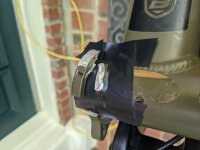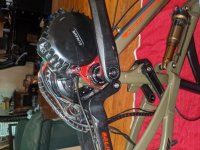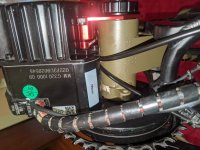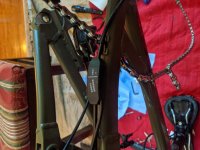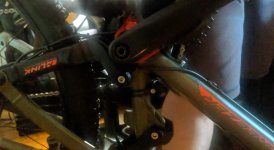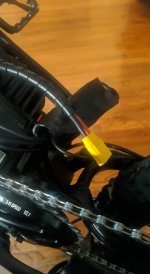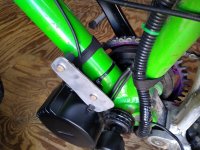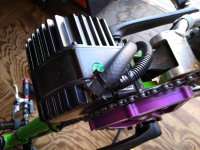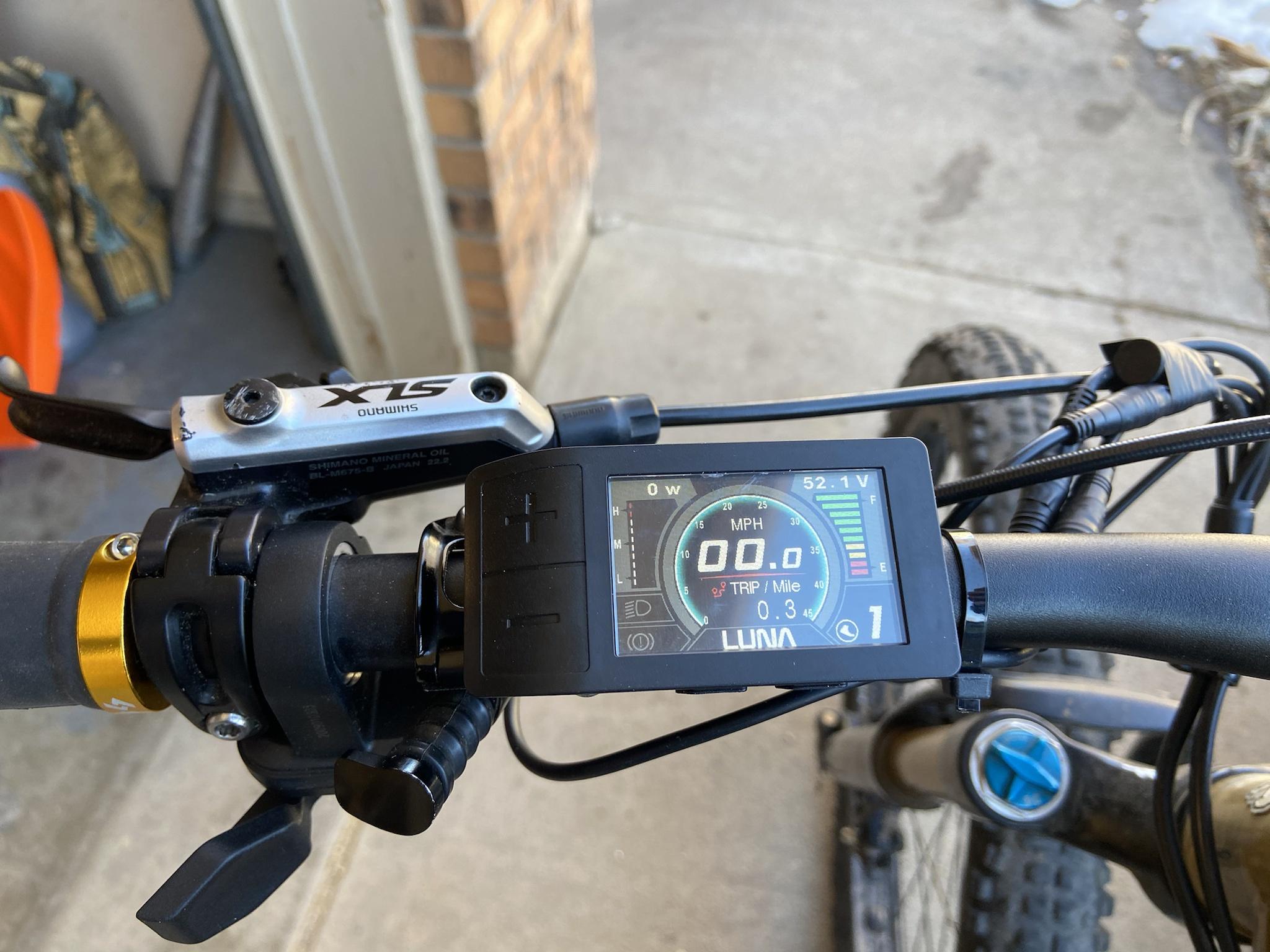geosped
100 W
- Joined
- Mar 18, 2015
- Messages
- 258
I'm gonna post some pics for those that are interested in a "real trail" bike. I posted good useful info on the pic's captions to make this easier to understand. Below are pics of a good bike if your intention is trail riding. This is like a Rubicon for Jeeps. It's heavy and beefy designed to go trail riding. It's got a very good component spec which should hold up better with the hard abuse of a 1000w motor. It's NOT a down hill beast and not meant to do large drops but can jump and is very capable all mountain bike. Bikes intention is to be a weekend warrior trail rider for a heavier rider. I' mostly ride blues (intermediate) to expert trails (black) very little jumping :-( At least not yet. If your a lighter rider under 200lbs I'd go with the BFANG BBS02 if your heavier over 200lbs I'm 235 I'd go with a BBSHD although the BBSHD is way overkill. It's way to much power and so far I've had 0 issues with the motor.
A couple of things and misconceptions for trail bike. This is an education thread and help you make an informed decisions when your looking for a donor bike. A lot of people use a FS MTB bike to start but and the information for Trail Riding can be misleading and you will quickly find your self looking at the wrong type of bikes. If you want to trail ride make sure you do the following when seeking out a good donor bike. If you follow these simple steps you will be a happier trail rider.
1) FRAME:
Make sure you pick a bike with a straight down tube. This will allow you to maximize how high you can stick the BBSHD up on the frame. Tubes with bends ultimately wont allow you to mount the motor high enough on the frame there by lowering your clearance meaning you will with absolute certainty be nailing stumps and large rocks when you go over them NOT GOOD! So forget Giant Bikes like the Anthem or Trance for example. This is not ideal for trail riding even though it's a great mtb. It does not make a good candidate for a diy emtb.
2) Battery Sizing:
Size your battery based on your riding style. Do NOT make the mistake of getting a 10ah or LARGER battery. There is no need and the larger battery only weighs you down. You dont need it and dont want it. In my case I'm 235lbs I use an 8ah 52v 21700 T40 Samsung cells. This battery allows me to ride for 20miles on intermediate to expert trails in North Georgia about 2hrs of riding and I still have some juice left over. If you ride more than that then go up to a 10ah. If you ride less than that then use 6.5ah. The 21700 cells are larger than the 18650's and provide plenty of discharge rate. The pack does not even get warm after a long climb or stretch.
3) Suspension Travel:
If you plan on riding TRAILS then do NOT GET A Cross Country XC bike as a donar. You will be tempted and there are a BUNCH of used bikes that fit the profile. But do your self a favor and get a "Trail, All Mountain, Enduro, or Down Hill" style BIKE ONLY!!!! The sweet spot is an All Mountain or Enduro. 140-180mm of travel. If the bike has 100mm of travel KEEP LOOKING!!!!
4) Wheel size:
A lot of folks say a 26" wheel is fine but I would disagree. A 26" wheel although your powered you do not have the same rolling resistance to carry your self over large obstacles. A 27.5 or 29"er is the ideal wheel size. Sure you can power pretty much over everything but it's much easier to roll over something where your not really slowing down you find your self loosing a lot of momentum. Find a bike with a 27.5 or 29" wheel. It will allow you to climb easier and more efficiently over anything and typically provide a bit more clearance underneath. They are also faster on the top end but slower on the start. The downside is there more expensive.
5) Motor Type:
For trail riding you want a mid drive so you can take advantage of your gears. Mid Drives are also more efficient when going uphill as they don't get heat soaked like a rear hub drive will. You also want the weight in the middle of the bike and NOT over the rear wheel. You need a good balanced center of gravity (COG). Smaller Chain Ring in front means more TORQUE Large Chain Ring in front means higher top end more SPEED. So if your mountain biking you want more torque. BUT be careful with a smaller chainring and chain line. You might not have enough offset with a small chain ring. For motors right now the options are fairly limited and BFANG BBSHD and BBS02 are the best bang for your buck options. There are better and more expensive options though. I use the BBSHD but the BBS02 is also a great option that provides plenty of power and is lighter and smaller but less power. Buy either option and you will be happy. Be carful when selecting a BFANG kit. These KITS IMO ARE NOT COMPLETE!!!!. You will need an after market chainring (lekkie or Luna), a cheap chain guide (keep chain from popping off), and shift sensor (cut's power to the motor while you shift) with out this you will tear up your drive train.
6) BB Bottom Bracket Length:
Make sure you figure out what kind of BB your using. There are a few good guides out. Measure the length underneath. BBSHD kits come in 68-73mm 73-86mm and 92mm they may even have a 100mm . They also have extension kits. For example my bike is using a Lekkie 86-92mm extension kit.
7) Nuances of newer frames and considerations:
Newer frames and or heavier duty bikes like All Moutain / Trail, DH or Enduro's may have ISCG tabs on the bottom bracket. Meaning this will interfere when you go to install a kit like the BBSHD. You will have to cut at least one tab off. Not a big deal with a Dremel but then again your cutting into your nice expensive bike. It can be a bit scary. These types of bikes will typically come with Press Fit Bottom Brackets so you will need an additional adapter and make sure you get the right size. Lastly chain line issues are a real issue as these beefier bikes are wider and dont allways align properly with the motor. So make sure you pay close attention to the chain stay clearance and chain line. Look at the Luna Eclipse chain rings they have a good tutorial on chain ring offset. My first emtb had a Lekkie 42T but this did not provide enough offset on my new bike so I got a Lunna 42T which has about 25mm of offset. Still wont be enough but it's the best I can do and NO I'm not taking an angle grinder to my BB.
A few drawbacks about the BFANG BBSHD. Throttle can be jerky. Reprograming of the FW will probably be required. What works for me is using the Start Current Sensor to 6 instead of 10 and make sure to set throttle Mode to Current (under throttle settings) One of the con's of the BBSHD is It comes with a crappy chain ring which will need to be replaced, Get a Luna Eclipse or a Lekkie, Another con is it typically does not come with a Shift Sensor make sure you get one. You also need to get a cheap chain guide. Make sure you get one. You really should consider all of these factors when pricing a kit as if you want the best possible experience you should do all of this stuff. Ask me how I know. I will say that the BBSHD is a BEAST. It's been very durable and reliable. It's extremely powerful. To give you an idea. I climbed a hill with a 2018 Specialized elevo in turbo mode and it's far far less powerful from a performance perspective that my BBSHD. Things that will help prevent your chain from popping off: Chain Guide, Narrow Wide chain ring and clutched derailleur. IMO the best bang for your buck here is the chain guide. But you really want all three. The lekkie and Luna chainrings are all Narrow / Wide teeth pattern so your good there and most newer higher end bikes have a clutched rear derailleur like Shimano XT.
Some additional considerations. Crank Arm's. Typical MTB crank arms are 170mm. This provides a lot of torque but with an emtb you don't really need such a long crank arm. Consider getting a 165mm crank arm. This will lower your chances of getting pedal strikes when riding.
On my particular build the only thing that I'm missing right now is what to do with battery. I will more than likely create a mount right above the motor and place it there on some sort of platform and secure it. I like the look under the sadel but this is not ideal especially when using a dropper post if your looking to bomb down some trails. You got to get your seat all the way down. In my case I still have plenty of clearance with the seat all the way down but it's still not ideal. I'm putting extra weight up high.
Let me know your thoughts and If I'm missed anything.
NOTEABLE PICS BELOW:
The pic with the chainline. This is a horrible chain line. This is one of the issues when selecting a bike like this. As you can see it's already using a Lekkie 42T which has an offset of 18.3. I'm going to swap this out to a Luna Eclipse 42T chain ring which has an offset of 24.8mm providing a bit more help. I dont think it's going to be enough. The reason you want a straight chain line is to prevent premature ware on your chain, rear cassette and chain ring. Chain is going to take the most abuse.
Chain Stay Pic. It's hard to see but I have plenty of clearance for a 42T chainring with more offset. You want to make sure that the teeth of the chainring will not touch the chainstay. If it does you will need to use bottom bracket spacers. On my last bike I had used three 1mm BB spacers.
Chain guide IMO great cheap insurance. Look at the inside of the chain guide. It's obvious the chain is getting slapped around and the chain guide is doing it's job. With out this if the chain pops off it may scratch and or do more damage to your frame.
A couple of things and misconceptions for trail bike. This is an education thread and help you make an informed decisions when your looking for a donor bike. A lot of people use a FS MTB bike to start but and the information for Trail Riding can be misleading and you will quickly find your self looking at the wrong type of bikes. If you want to trail ride make sure you do the following when seeking out a good donor bike. If you follow these simple steps you will be a happier trail rider.
1) FRAME:
Make sure you pick a bike with a straight down tube. This will allow you to maximize how high you can stick the BBSHD up on the frame. Tubes with bends ultimately wont allow you to mount the motor high enough on the frame there by lowering your clearance meaning you will with absolute certainty be nailing stumps and large rocks when you go over them NOT GOOD! So forget Giant Bikes like the Anthem or Trance for example. This is not ideal for trail riding even though it's a great mtb. It does not make a good candidate for a diy emtb.
2) Battery Sizing:
Size your battery based on your riding style. Do NOT make the mistake of getting a 10ah or LARGER battery. There is no need and the larger battery only weighs you down. You dont need it and dont want it. In my case I'm 235lbs I use an 8ah 52v 21700 T40 Samsung cells. This battery allows me to ride for 20miles on intermediate to expert trails in North Georgia about 2hrs of riding and I still have some juice left over. If you ride more than that then go up to a 10ah. If you ride less than that then use 6.5ah. The 21700 cells are larger than the 18650's and provide plenty of discharge rate. The pack does not even get warm after a long climb or stretch.
3) Suspension Travel:
If you plan on riding TRAILS then do NOT GET A Cross Country XC bike as a donar. You will be tempted and there are a BUNCH of used bikes that fit the profile. But do your self a favor and get a "Trail, All Mountain, Enduro, or Down Hill" style BIKE ONLY!!!! The sweet spot is an All Mountain or Enduro. 140-180mm of travel. If the bike has 100mm of travel KEEP LOOKING!!!!
4) Wheel size:
A lot of folks say a 26" wheel is fine but I would disagree. A 26" wheel although your powered you do not have the same rolling resistance to carry your self over large obstacles. A 27.5 or 29"er is the ideal wheel size. Sure you can power pretty much over everything but it's much easier to roll over something where your not really slowing down you find your self loosing a lot of momentum. Find a bike with a 27.5 or 29" wheel. It will allow you to climb easier and more efficiently over anything and typically provide a bit more clearance underneath. They are also faster on the top end but slower on the start. The downside is there more expensive.
5) Motor Type:
For trail riding you want a mid drive so you can take advantage of your gears. Mid Drives are also more efficient when going uphill as they don't get heat soaked like a rear hub drive will. You also want the weight in the middle of the bike and NOT over the rear wheel. You need a good balanced center of gravity (COG). Smaller Chain Ring in front means more TORQUE Large Chain Ring in front means higher top end more SPEED. So if your mountain biking you want more torque. BUT be careful with a smaller chainring and chain line. You might not have enough offset with a small chain ring. For motors right now the options are fairly limited and BFANG BBSHD and BBS02 are the best bang for your buck options. There are better and more expensive options though. I use the BBSHD but the BBS02 is also a great option that provides plenty of power and is lighter and smaller but less power. Buy either option and you will be happy. Be carful when selecting a BFANG kit. These KITS IMO ARE NOT COMPLETE!!!!. You will need an after market chainring (lekkie or Luna), a cheap chain guide (keep chain from popping off), and shift sensor (cut's power to the motor while you shift) with out this you will tear up your drive train.
6) BB Bottom Bracket Length:
Make sure you figure out what kind of BB your using. There are a few good guides out. Measure the length underneath. BBSHD kits come in 68-73mm 73-86mm and 92mm they may even have a 100mm . They also have extension kits. For example my bike is using a Lekkie 86-92mm extension kit.
7) Nuances of newer frames and considerations:
Newer frames and or heavier duty bikes like All Moutain / Trail, DH or Enduro's may have ISCG tabs on the bottom bracket. Meaning this will interfere when you go to install a kit like the BBSHD. You will have to cut at least one tab off. Not a big deal with a Dremel but then again your cutting into your nice expensive bike. It can be a bit scary. These types of bikes will typically come with Press Fit Bottom Brackets so you will need an additional adapter and make sure you get the right size. Lastly chain line issues are a real issue as these beefier bikes are wider and dont allways align properly with the motor. So make sure you pay close attention to the chain stay clearance and chain line. Look at the Luna Eclipse chain rings they have a good tutorial on chain ring offset. My first emtb had a Lekkie 42T but this did not provide enough offset on my new bike so I got a Lunna 42T which has about 25mm of offset. Still wont be enough but it's the best I can do and NO I'm not taking an angle grinder to my BB.
A few drawbacks about the BFANG BBSHD. Throttle can be jerky. Reprograming of the FW will probably be required. What works for me is using the Start Current Sensor to 6 instead of 10 and make sure to set throttle Mode to Current (under throttle settings) One of the con's of the BBSHD is It comes with a crappy chain ring which will need to be replaced, Get a Luna Eclipse or a Lekkie, Another con is it typically does not come with a Shift Sensor make sure you get one. You also need to get a cheap chain guide. Make sure you get one. You really should consider all of these factors when pricing a kit as if you want the best possible experience you should do all of this stuff. Ask me how I know. I will say that the BBSHD is a BEAST. It's been very durable and reliable. It's extremely powerful. To give you an idea. I climbed a hill with a 2018 Specialized elevo in turbo mode and it's far far less powerful from a performance perspective that my BBSHD. Things that will help prevent your chain from popping off: Chain Guide, Narrow Wide chain ring and clutched derailleur. IMO the best bang for your buck here is the chain guide. But you really want all three. The lekkie and Luna chainrings are all Narrow / Wide teeth pattern so your good there and most newer higher end bikes have a clutched rear derailleur like Shimano XT.
Some additional considerations. Crank Arm's. Typical MTB crank arms are 170mm. This provides a lot of torque but with an emtb you don't really need such a long crank arm. Consider getting a 165mm crank arm. This will lower your chances of getting pedal strikes when riding.
On my particular build the only thing that I'm missing right now is what to do with battery. I will more than likely create a mount right above the motor and place it there on some sort of platform and secure it. I like the look under the sadel but this is not ideal especially when using a dropper post if your looking to bomb down some trails. You got to get your seat all the way down. In my case I still have plenty of clearance with the seat all the way down but it's still not ideal. I'm putting extra weight up high.
Let me know your thoughts and If I'm missed anything.
NOTEABLE PICS BELOW:
The pic with the chainline. This is a horrible chain line. This is one of the issues when selecting a bike like this. As you can see it's already using a Lekkie 42T which has an offset of 18.3. I'm going to swap this out to a Luna Eclipse 42T chain ring which has an offset of 24.8mm providing a bit more help. I dont think it's going to be enough. The reason you want a straight chain line is to prevent premature ware on your chain, rear cassette and chain ring. Chain is going to take the most abuse.
Chain Stay Pic. It's hard to see but I have plenty of clearance for a 42T chainring with more offset. You want to make sure that the teeth of the chainring will not touch the chainstay. If it does you will need to use bottom bracket spacers. On my last bike I had used three 1mm BB spacers.
Chain guide IMO great cheap insurance. Look at the inside of the chain guide. It's obvious the chain is getting slapped around and the chain guide is doing it's job. With out this if the chain pops off it may scratch and or do more damage to your frame.
Attachments
-
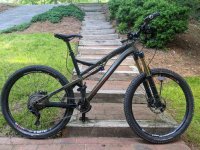 186510391_10225911758570287_5146930485759320443_n (1).jpg210.5 KB · Views: 2,197
186510391_10225911758570287_5146930485759320443_n (1).jpg210.5 KB · Views: 2,197 -
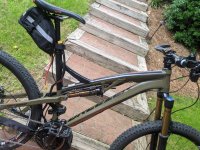 195387698_10226056755475119_8323146300169404699_n.jpg753.3 KB · Views: 2,192
195387698_10226056755475119_8323146300169404699_n.jpg753.3 KB · Views: 2,192 -
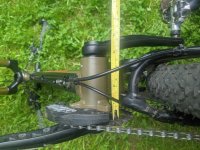 PXL_20210508_140549202.jpg424.7 KB · Views: 2,192
PXL_20210508_140549202.jpg424.7 KB · Views: 2,192 -
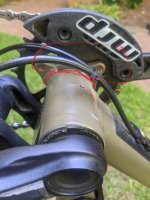 PXL_20210509_132435913.jpg189.4 KB · Views: 2,193
PXL_20210509_132435913.jpg189.4 KB · Views: 2,193 -
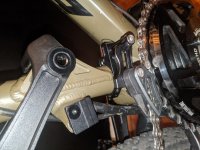 PXL_20210609_205133424.jpg418.5 KB · Views: 2,187
PXL_20210609_205133424.jpg418.5 KB · Views: 2,187 -
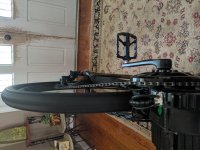 PXL_20210609_190646965.jpg427.3 KB · Views: 2,187
PXL_20210609_190646965.jpg427.3 KB · Views: 2,187 -
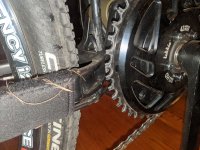 PXL_20210605_135150742.jpg477.8 KB · Views: 2,192
PXL_20210605_135150742.jpg477.8 KB · Views: 2,192


